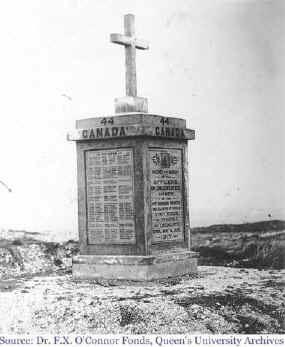
To Our Soldier Boys
To you, O Men of the Singing Souls,
A sacred pledge, we give in fee,
The proud, high name of our mother Queen's,
To bear as yours, beyond the sea.
Because you are noble and strong and good,
We give to your keeping, our crest of gold,
That an age-old bond of our motherhood
May bind us all in her sacred fold.
And the sun sinks low, and the twilight falls
On your long trench lines and our campus grey,
And over the world the Queen's voice calls,
To those who are absent, at closing day
And then in the halls of our Mother's home,
We shall keep the fires and tapers aglow
Till the trumpets burst with a triumph blast
For the new fledged heroes of long ago.
To each has been given his separate vial
The draught of life, or the draught of love.
Thine is the sweeter and in the while.
May ours to the taste, not tasteless prove.
Charlotte Whitton
Queen's Arts, M.A., 1917
Canada: A Nation Evolves
World War I was very influential in the shaping of Canada as a nation. Canada earned recognition, respect and admiration from the rest of the world through their successful and dedicated participation in WWI. Canadians successfully participated in a war that introduced the horrors of modern warfare to the world. Technology developed at a rapid pace during WWI because of the increasing demands of modern warfare.
Although many Canadian lives were lost during the war, Canada grew stronger as a nation, and moved closer to becoming an independent nation. A distinctive and lasting Canadian identity was forged on the battlefields of Europe during WWI. Canadian women also made tremendous strides during the war, some voting for the first time, several serving as nurses and volunteers at the front, and many others becoming well established in the Canadian labor force.
World War I brought many issues of racism to the forefront in Canada. The unjust internment of many "enemy aliens" or immigrants from "enemy" countries in Canada during WWI will be remembered as one of the most embarrassing aspects of Canadian history. The immigrant population of Canada today, including those who came from war torn Europe after 1918, has become a major part of the Canadian identity.
How Does this Archival Material fit into the Curriculum?
The following is a list of specific curriculum expectations that can be met with the aid of the materials and ideas presented on this website. These expectations are taken directly from, "The Ontario Curriculum Grades 9 and 10: Canadian and World Studies (1999)" official Ministry of Education and Training curriculum document.
- explain how Canada became involved in World War I, after researching the cause of the war;
- demonstrate a knowledge of Canada's military contributions in World War I (e.g., Ypres);
- evaluate Canada's role in the Allied victories of World War I;
- describe how Canadians of various ethno-cultural backgrounds. individually and as communities, contributed at home and overseas to the war effort during World War I.
- explain how and why development in transportation and communication technology affected life during the twentieth century;
- examine the relationship between war and inventions and examine how wartime inventions changed life during and after World War I;
- explain how significant individuals (e.g., Robert Borden, Billy Bishop) contributed to the growing sense of Canadian identity during World War I;
- explain how and why the Canadian government restricted certain rights and freedoms in wartime, and describe the impact, both short and long-term, of these restrictions on the general population and on various groups within the Canadian population;
- use computer-stored information and the Internet effectively to research Canadian history topics;
- distinguish between primary and secondary sources of information, and demonstrate an understanding of how to use each appropriately in historical research;
- distinguish between fact and inference in primary and secondary sources;
- express ideas and arguments in a coherent manner during discussions and debates, or in graphic displays;
- demonstrate, after participating in dramatizations of historical events, insights into historical figures' situations and decisions.
